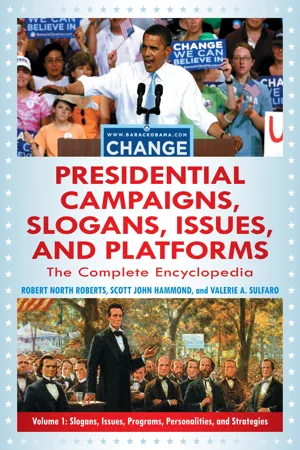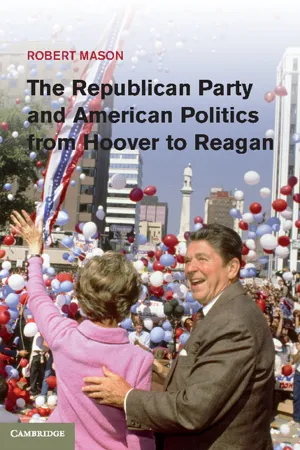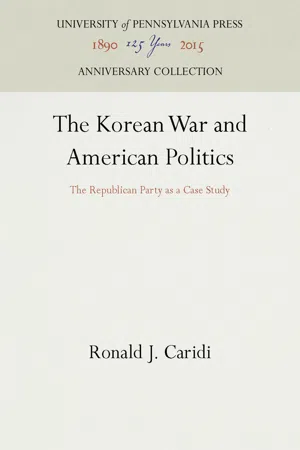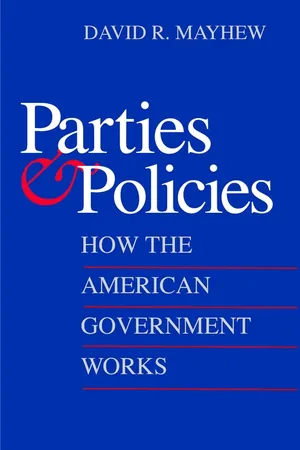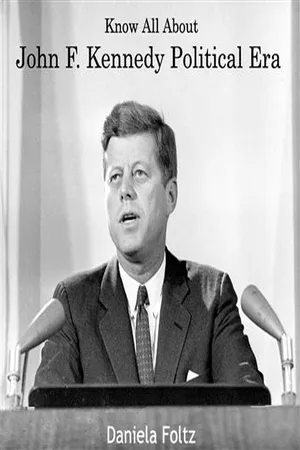History
1952 Presidential Election
The Presidential Election of 1952 in the United States saw Republican candidate Dwight D. Eisenhower defeating Democratic candidate Adlai Stevenson. Eisenhower's military background and promise to end the Korean War contributed to his victory. This election marked a shift in American politics, as Eisenhower's landslide win ended 20 years of Democratic control of the White House.
Written by Perlego with AI-assistance
Related key terms
1 of 5
6 Key excerpts on "1952 Presidential Election"
- eBook - ePub
Presidential Campaigns, Slogans, Issues, and Platforms
The Complete Encyclopedia [3 volumes]
- Robert North Roberts, Scott John Hammond, Valerie A. Sulfaro(Authors)
- 2012(Publication Date)
- Greenwood(Publisher)
On Election Day, President Eisenhower was returned to office in a landslide, winning over 35,000,000 popular votes, or 57 percent, to Stevenson’s approximately 26,000,000 votes, which amounted to just under 42 percent, a crushing victory that converted to a still more impressive win in the Electoral College, where the President won 457 electoral votes (86%) to Stevenson’s 73 (14%). Eisenhower again swept the Northeast, Midwest, and West, holding every state that he had won in 1952 except the border state of Missouri, and in exchange gained three states: Louisiana, Kentucky, and West Virginia. To this point, only four candidates had won a larger percentage of the popular vote: Franklin Roosevelt in 1936 and 1932 (Eisenhower’s victory was a .04% points behind FDR’s 1932 landslide), Warren Harding in 1920, and Herbert Hoover in 1928. Perhaps even more telling, Eisenhower’s separate percentages of the popular vote in 1952 and 1956 were both higher than President Roosevelt’s in the elections of 1940 and 1944; and as stated above, his 1956 share was virtually the same as Roosevelt’s 1932 share, evidence that the Republican Party had completely rebounded from the doldrums of the 1930s and the lingering effects in the early 1940s. Eisenhower was also the first Republican to win a second term since Theodore Roosevelt (and the first Republican to be elected twice—Roosevelt’s first term the result of ascension upon the death of a president—since President McKinley in 1900). Eisenhower’s immense popularity did not come with very long coattails, for the Democrats retained control of both houses of Congress.President Eisenhower would leave office in 1960 as the last president to have been born in the nineteenth century, and as the country moved into the decade of the 1960s, youth and the fresh outlooks that come with it would set the tone for the politics and culture of the next generation. Nonetheless, the Eisenhower administration was an important factor in prompting those myriad changes that would be later associated with the youth movement of the future, and it stood at a critical moment in the history of the republic. And at the center of it was the steady presence of President Eisenhower himself, whose calm influence may have been the right element for the times. Today Eisenhower’s legacy is viewed positively; most presidential scholars and historians rank him among the nation’s 10 best chief executives, and regard him as a “near great” president. Rankings aside, his presidency fares well when considering the things at stake during his administration and his steady demeanor throughout his two terms. In the words of journalist Andy Rooney, “Eisenhower was the quintessential American to me. He meant to do the right thing. He was honest. I think he is the great American hero of our time.” - Robert Mason(Author)
- 2011(Publication Date)
- Cambridge University Press(Publisher)
148 5 “Modern Republicanism”: 1953–1961 Dwight Eisenhower’s popularity and 1952’s victories encouraged high hopes for the Republican future. “There is every reason to suppose,” wrote journalist Richard Rovere in June 1953, “that with good management and just a small amount of luck [the Republicans] can build as formidable a series of political alliances as the Democrats built back in the thirties.” 1 Eisenhower’s remarkable political appeal was especially important in fos- tering such hopes; he enjoyed national popularity of a breadth and depth rarely paralleled in American history. 2 A crowd’s enthusiasm for him at a 1956 appearance caused one foreign journalist to remark, “I haven’t seen anything like this since Hitler.” 3 At the White House he lost little of his popularity gained as a war hero; studies suggested that positive personal evaluations of him were even more extensive among Americans in 1956 than 1952 – enough to suggest to poll analysts that his reelection success relied more heavily on his strength as a political personality than on his presidential achievements. 4 The Republican Party failed to realize the hopes that Rovere outlined, how- ever. Instead, the 1950s proved to be a decade of declining fortunes. In 1954, the party lost its narrow majorities in Congress. In 1956, despite Eisenhower’s landslide reelection to the presidency, Republicans failed to regain any ground on Capitol Hill. The results indicated, according to one reporter, “both the increasing grass-roots popularity of President Eisenhower and the increasing grass-roots unpopularity of the Republican party.” The results of the 1958 midterms then provided unambiguous evidence of the party’s weakness, as 1 Richard H. Rovere, Affairs of State: The Eisenhower Years (New York: Farrar, Straus and Cudahy, 1956), 115. 2 Herbert H. Hyman and Paul B. Sheatsley, “The Political Appeal of President Eisenhower,” POQ 17 (1953–1954), 443–460.- eBook - PDF
The Korean War and American Politics
The Republican Party as a Case Study
- Ronald J. Caridi(Author)
- 2016(Publication Date)
a a o The American people went to the polls on November 4th and registered an impressive victory for General Eisenhower. The total popular vote was 61.5 million; Eisenhower won 33.8 million votes to Stevenson's 27.3 million. In terms of percen-tage, the General received almost 55 percent of the votes cast to his opponent's 44.3 percent. The electoral count was 442 to 89. The Republicans, however, did not fare nearly so well in the congressional elections. In the Eighty-second Congress the Democrats had had a two-vote lead in the Senate; as a result of the 1952 election and Morse's becoming an Independent, the Republicans held 48 seats in the new Congress, giving them a one-vote lead over the Democrats. In the House the GOP picked up 22 seats, thereby gaining a slim marginal lead, 221 to 213. Less than two weeks after the election U.S. News ir World 70 The New York Times, October 9, 1952, p. 24. 244 THE KOREAN WAR AND AMERICAN POLITICS Report published the results of an interview that they con-ducted among certain chief figures in the race. Taft alone did not believe that Korea was the deciding factor, citing instead the public's desire to get rid of the New Deal—that is, the people were fundamentally against the whole spending-taxa-tion philosophy. 71 Taft did, however, believe that this issue was intensified tremendously by corruption, Korea, and Communism. The man who defeated Taft for the nomination in 1948, Governor Dewey, believed that Korea was the major issue of the campaign. I think that [the voters] understood the Administration had failed to realize the danger in Korea and had blundered us into a situation where a vacuum was created, and where, in effect, the Communists were invited in by the Administration. 72 House Leader Martin gave the same reason, stressing the effect of the President-elect's promise to go to Korea. - eBook - PDF
Parties and Policies
How the American Government Works
- David R. Mayhew(Author)
- 2008(Publication Date)
- Yale University Press(Publisher)
π∏ Beyond Roosevelt, the party’s prospects were blurry. Crisis management would not go away. Four years later, the ongoing war 384 Incumbency in Presidential Elections dominated the election of 1944. The election of 1948 is often romanticized as a succession of Truman’s whistle-stops and give-’em-hell speeches, but in fact it took place during the scary—we have forgotten just how scary—Berlin crisis of that year, which the incumbent president seemed to be managing well. ππ Casually we write of a long continuing New Deal era, but on the political side the 1940s was a good deal dicier than that. Incumbency probably aided the Democrats. There wasn’t any long rock-solid hegemonic party era. Tweak the contingencies a bit and we might be writing of an Age of Willkie or an Age of Dewey. Notes Thanks to Christopher Achen, Larry Bartels, Robert Dahl, Alan Gerber, Donald Green, Jacob Hacker, Sonam Henderson, Michael F. Holt, Gary Jacob-son, Rogan Kersh, John Lapinski, Joel Middleton, William Nordhaus, Joseph Sempolinski, Stephen Skowronek, Jennifer Steen, and anonymous reviewers for their help on this essay, which is published in Political Science Quarterly 123:2 (summer 2008). 1. See the argument in David R. Mayhew, Electoral Realignments: A Critique of an American Genre (New Haven, CT: Yale University Press, 2002), ch. 4. 2. Daniel J. Gans, ‘‘Persistence of Party Success in American Presidential Elections,’’ Journal of Interdisciplinary History 16 (Winter 1986): 228–30. 3. James L. Huston, The Panic of 1857 and the Coming of the Civil War (Baton Rouge: Louisiana State University Press, 1987), ch. 6. In particular, a Republican surge in the coal and iron areas of Pennsylvania, then the second largest state, following the Panic of 1857 helped loft the party to long-term control of the U.S. House. Of course, slavery was a major nationwide concern in 1858 also. 4. Of course not all congressional takeovers are economy driven, as the elections of 1994 and 2006 attest. - eBook - PDF
America since 1945
The American Moment
- Paul Levine, Harry Papasotiriou(Authors)
- 2010(Publication Date)
- Red Globe Press(Publisher)
Every Republican presidential candidate since 1940 had come from this wing. Taft led the more isolationist and ‘Asia first’ wing that was stronger in the heartland; he opposed aid to Europe, embraced McCarthyism and remained anti-New Deal. The fight at the convention was quite close in spite of a string of Eisenhower victories at the primaries. Once Eisenhower secured the nomination, he balanced the ticket by selecting as his running mate Richard Nixon, who came from the West and represented the more respectable face of the Red hunt. Eisenhower deeply detested McCarthy and his closest allies, but did not risk a full break with them at this point. In the general election Eisenhower won with 55.4 percent of the vote and 442 Electoral College votes against Stevenson’s 89. He managed even to carry four states in the outer South. Control of Congress also changed hands, though the AMERICAN POLITICS FROM TRUMAN TO EISENHOWER 63 Republican majorities were slim in both chambers. For the first time since 1930, the Republicans controlled both the presidency and Congress. Nonetheless, this election constituted only an ephemeral weakening of the New Deal coalition. The Democrats regained control of both chambers of Congress in the midterm elections of 1954. In 1956 Eisenhower was reelected with 57 percent of the vote (again facing the unfortunate Stevenson), yet the American people reelected Democratic majorities in Congress. The resilience of the New Deal coalition was demonstrated especially in the midterm elections of 1958, after which the Democratic congressional majorities were 283 against 154 in the House and 65 against 35 in the Senate. The Democrats also occupied 34 out of 50 governorships and had a similar superiority in the state legisla-tures. They also had a steady advantage in party identification, with almost 50 percent in opinion polls identifying themselves as Democrats, about 30 percent as Republicans and slightly over 20 percent as Independents. - No longer available |Learn more
- (Author)
- 2014(Publication Date)
- The English Press(Publisher)
________________________ WORLD TECHNOLOGIES ________________________ Chapter-1 United States Presidential Election, 1960 United States presidential election, 1960 1956 ← November 8, 1960 → 1964 Nominee John F. Kennedy Richard Nixon Party Democratic Republican Home state Massachusetts California Running mate Lyndon B. Johnson Henry Cabot Lodge, Jr. Electoral vote 303 219 States carried 22 26 Popular vote 34,220,984 34,108,157 Percentage 49.7% 49.6% ________________________ WORLD TECHNOLOGIES ________________________ Presidential election results map. Blue denotes states won by Kennedy/Johnson, Red denotes those won by Nixon/Lodge. Orange denotes the electoral votes for Harry F. Byrd by Alabama and Mississippi unpledged electors, and an Oklahoma faithless elector. Numbers indicate the number of electoral votes allotted to each state. President before election Dwight D. Eisenhower Republican Elected President John F. Kennedy Democratic The United States presidential election of 1960 was the 44th American presidential election, held on November 8th, 1960, for the term beginning January 20, 1961, and ending January 20, 1965. The incumbent president, Republican Dwight D. Eisenhower, was not eligible to run again. The Republican Party nominated Richard M. Nixon, Eisenhower's Vice-President, while the Democrats nominated John F. Kennedy, the junior Senator from Massachusetts. Eventually, Kennedy was elected with a lead of 112,827 votes, or 0.1% of the popular vote, giving him a victory of 303 to 219 in the Electoral College, the closest since 1916. There has been controversy among some historians as to whether vote theft in selected states aided Kennedy's victory. This election saw Southern anger at the pro-civil rights stances of Kennedy and Nixon. Mississippi and Alabama sent uncommitted electors to the Electoral College: eventually, these voted for Harry F.
Index pages curate the most relevant extracts from our library of academic textbooks. They’ve been created using an in-house natural language model (NLM), each adding context and meaning to key research topics.
